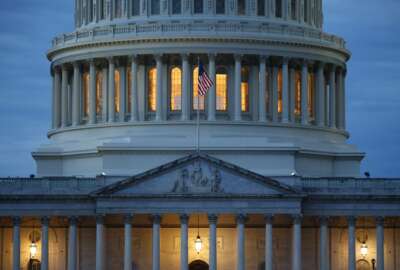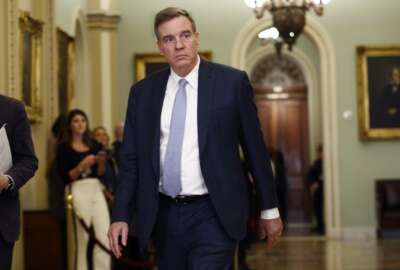
CARES Act funds for nonprofits still stuck in distribution
Billions from the CARES Act, passed in March and intended for struggling non-profits, are still bottled up in bureaucracy.
[Correction: The interviewee stated that the National Endowment for the Arts had not committed its CARES Act relief funds by the time of the interview. The Endowment reports having designated all of its $75 million in CARES Act funding within 14 weeks of the law’s enactment, or by July 1st ]
Best listening experience is on Chrome, Firefox or Safari. Subscribe to Federal Drive’s daily audio interviews on Apple Podcasts or PodcastOne.
Congress might be preparing another big spend on coronavirus relief. But billions from the CARES Act, passed in March and intended for struggling non-profits such as museums and arts organizations, are still bottled up in the bureaucracy. That’s the major finding of a fellow in public finance at Rice University’s Baker Institute for Public Policy, Joyce Beebe, who joined Federal Drive with Tom Temin with more.
Interview transcript:
Tom Temin: Mrs. Beebe, good to have you on.
Joyce Beebe: Thank you, Tom.
Tom Temin: Now you’ve looked at the cares act spending and we know that billions did go out for personal payments to individuals and so on. But what’s going on with some of these other funds? Tell us about the funds and what’s going on that you’ve discovered?
Joyce Beebe: Yes. So far, the federal government has responded with four major relief packages and currently we’re negotiating the number five. And the CARES Act is the third federal relief package and the biggest one among the four so far, and the second package the Family Frst Coronavirus Response Act uncommonly known as FFCRA. Together with the CARES Act and other coronavirus relief packages, provided billions of funds to as you mentioned emergency food assistance as everybody are aware of that. The food bank, for example, are under really high demand for many low income or persons in need. So they not only have trouble recruiting volunteers, and maintain people on payroll, they also have to compete with say grocery stores or other food suppliers in providing food available to certain communities. And obviously other things like YMCA, they are obligated to keep operating their childcare services but certain programs are cut. So the federal government does have them in mind by providing and passing the laws, the FFCRA and CARES Act for additional funding for their services that the federal government recognized, that Congress recognized the importance of their services to our community. However, the distribution or dispense of the funds is not as fast as we would hoped. And some preliminary findings or the data released by the government, federal government, in terms of how fast these funds are distributed disapoingtinly show that about probably 30% to about 40-50% of the funds are given to those agencies they’re in need right now.
Tom Temin: Got it. So there’s a lot of money yet to go out. Now. Let’s talk about one of these the $400 million to the Commodity Assistance Program, and this is for, itwould help food distribution. What is the situation with that particular program?
Joyce Beebe: So basically, the government has through the second and a third of the relief measure combined allowed $850 million for this food assistance program. But what’s how thing is that well, this is a new program and they have to really create a channel or a measure through which the funds can go out. So pretty much similar to other measures that’s passed through the CARES Act, some federal agencies have to basically based on the law, write the regulations and that’s what slowing them down. And the other programs are going to go through the state government. So that adds another layer of the bureaucracy, if you will. And this is true for that particular program for the food bank assistance, Food Emergency Assistance Program. And there’s other things say for the block grants or the community services and other things that has to go through the state. So you add another layer of bureaucracy right there. So one element for the Food Assistance Program, for example, the Supplemental Nutrition Assistance Program given to the low income community through the SNAP program or the WIC, WIC is for women, infant and children. So that is responsible by the Department of Agriculture. So they had to really dispense the fund to the local or state agencies. And obviously, the state local agencies are also hit by the disruptional operations for the local operations. So they had to close their offices at the state for example. So that’s slowed things down.
Tom Temin: You also mentioned $3.5 billion Child Care and Development Block Grant. And has that been given out? If not how much is yet to go there and what does that money do?
Joyce Beebe: So slowly, that is one of the programs that the federal government has to give out to the state level. So obviously, a lot of childcare agencies or ventures has been shut down and the federal government is recognizing this. And as the economy slowly recovers or reopens, a few childcare agencies have slowly reopened and now it’s more and more. So in order to enable workers to go back to work, this is important and the federal government is recognizing that need and get the state the authority to allow the childcare agencies to apply for this grant. Today, I would say slowly, it’s increasing the portion of the funds. It’s there. It’s slowly giving out but it’s still not as high as we would have hoped. And would you say that getting money to childcare providing organizations is in some ways a catalyst for the greater economy so the parents can get back to work more easily? Certainly, that’s very important. And not only reopening the facility, but that will keep the childcare workers employment, enable tons of workers the parents that have young children to go be able to go to work. And also that’s a very, very major benefit for the child development as well. Because from March to today, almost six months of sitting at home, either homeschooling or staying with your parents only, it’s very important for the child to go back for mental reasons and enabling the parents to return to work.
Tom Temin: Everybody has a mental reason for the kids to go back to school. I think, or back to childcare.
Joyce Beebe: Right, exactly.
Tom Temin: What about funds for arts organizations and the National Endowment for the Arts and orchestras and opera companies and that kind of thing?
Joyce Beebe: So obviously those art and museums and symphonies, they are suffering in a slightly different way, say from the food bank. The food banks have huge demand. They have to basically be operating at full throttle for the operations, probably have a surge demand. The museum and symphony unfortunately, had to shut down their concert halls and the exhibits, so they lose the operation revenue right away. But in order to keep the musicians and the staff payroll, they still have those personnel costs. And right now, even if the economy is reopening, they cannot fully operate at 100% and recoup their losses. And some of their visitors may not even feel safe to go back. So they’re forced to sort of slowly go back or either providing the live stream of say some of their exhibits or music. So they not only are facing a different type of challenge in terms of loss of revenue, they also are facing another challenge, say I have to modify my delivery in order to keep my visitors or donors if you will. So there are some money earmarked in terms of a grant for National Endowment of the Arts and National Endowment for Humanity. They are also in the form of block grants, and they are slowly going out, not as fast as we would like to. So again, going back to the original idea that the federal government really needs to just disperse those funds as soon as possible, in addition to negotiating the current fifth relief package.
Tom Temin: Got it. Yeah, let’s spend what we’ve got and then see what happens, I guess maybe, wouldve been a better strategy.
Joyce Beebe: Right. And also, I’d like to mention, many nonprofits have voiced their concerns about the existing programs that the federal government’s already approved. So everybody, by now, profit or nonprofit, probably heard about the PPP, paycheck protection program, and it expired on August 8. So basically, all the nonprofit or different industries came out to the Congress and say, hey please modify the terms of the PPP. Because right now since the economy is slowly going back to normal, we need to focus on not only the payroll protection, you need to focus on the operation and give a sound liquidity or money to revamp our operation. So different organizations want the TPP to be revised in a slightly different way. And PPP is really a generous program in comparison to typical loans. However, Congress really needs to weigh in different type of requests. So for example, a lot of nonprofits, hundreds of them, wrote to the Congressional leaders and say, please make the PPP more generous to nonprofit organizations, and perhaps you can get rid of the limitation in terms of the number of employees so more nonprofits can benefit. And also that maybe you can make some of those loans not only limited to paycheck protection, because right now reopening our operations or reopening our concert halls or museums is more important, and we need to use that money to buy protective gears and training our employees, for example.
Tom Temin: Joyce Beebe is a fellow in public finance at Rice University’s Baker Institute for Public Policy. Thanks so much for joining me.
Joyce Beebe: Thank you. Thank you Tom.
Copyright © 2024 Federal News Network. All rights reserved. This website is not intended for users located within the European Economic Area.
Tom Temin is host of the Federal Drive and has been providing insight on federal technology and management issues for more than 30 years.
Follow @tteminWFED





